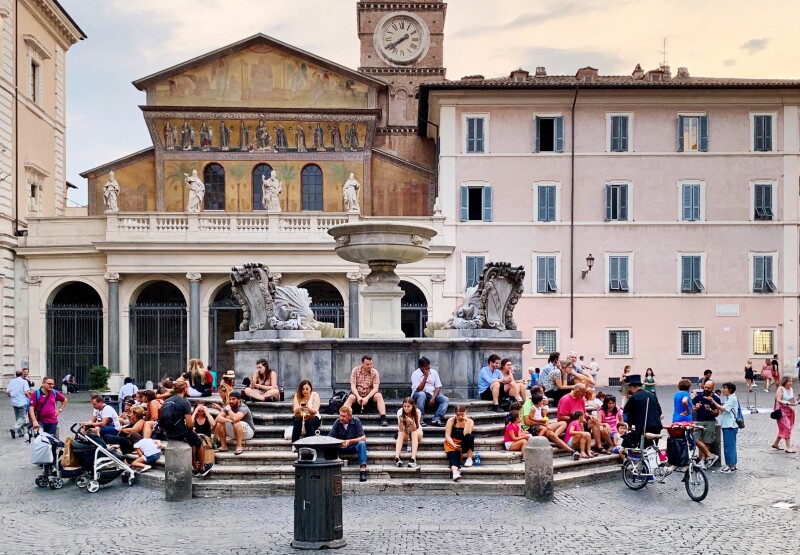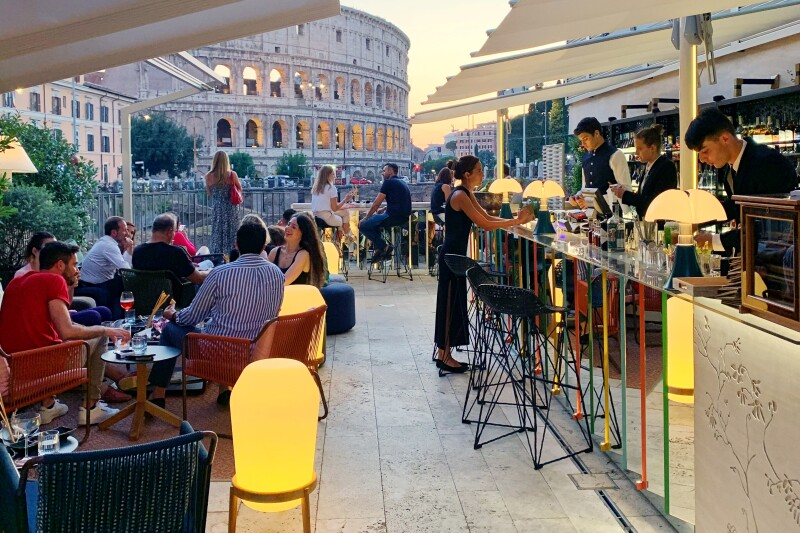Baroque churches containing artistic masterpieces, gurgling fountains, cocktails clinking on rooftop terraces, freshly baked pizza bianca—these are some of the sights, sounds, and scents that await you in Rome. You could explore ancient ruins in the morning, eat spaghetti carbonara at a trattoria for lunch, and sip creative cocktails at one of the city’s coolest bars at night. Now, thanks to an influx of hip new hotels and restaurants, plus reopened archaeological sites, Rome is definitely having a moment. After nearly five years of living here and more than a decade of visiting prior to that, I’ve gotten to know the best of the old and the new. This itinerary, designed for a Thursday to Sunday, reveals my insider intel as well as that of a few local experts.
Thursday: Get your bearings with a Vespa tour and dive deep into Trastevere

Trastevere, home to the Piazza di Santa Maria, is still one of Rome’s buzziest neighborhoods.
Photo by Laura Itzkowitz
Whenever my family and friends come to Rome, I tell them to do a Vespa tour with Scooteroma and everyone raves about it. Hop on the back for a three-hour tour and feel the wind in your hair as one of their professional drivers-guides shows you the sights. Its classic tour is perfect for first-time visitors, but it also has several themed tours, including a street art tour, cinema tour, and foodie tour.
The tour will end just in time for lunch, so ask your guide to drop you off in Trastevere, one of the most quintessential Roman neighborhoods. Once a working-class area, it has gentrified over the years, but is still characterized by narrow cobblestone lanes draped with ivy and laundry hanging from the windows of apartments. Maria Pasquale, an award-winning Italian Australian journalist and author of several books, including Eternal City: Recipes & Stories from Rome, has called the neighborhood home for more than a decade. For a quick lunch she recommends the take-out spot Supplì, saying it offers “a taste of true Roman street fare.” In addition to the supplì (fried rice balls with a breadcrumb crust), she recommends the marinara pizza, which she calls “thin, crispy, and super saucy, with just the right balance of garlic, herbs, and tomato.” Bring your food a couple of blocks to the Piazza di Santa Maria in Trastevere and take a seat on the steps of the fountain, which is like the neighborhood’s living room, where locals and tourists hang out, enjoy the sunshine, and perhaps smoke a cigarette surrounded by bustling sidewalk cafés.
Afterwards, if you need a pick-me-up, pop into Bar San Calisto, an authentic no-frills spot where you’re as likely to spot a group of old men playing cards as a young musician drinking a beer in the sunshine. Join the Romans having a quick espresso at the bar or take a seat at the tables out front for some prime people-watching. From there, you’re only a 10-minute walk to Villa Farnesina, one of Rome’s best and most underrated sites. Commissioned by the wealthy banker Agostino Chigi on the occasion of his marriage, the villa contains incredible ceiling frescoes painted by Raphael in 1518, which depict the marriage of Cupid and Psyche.
For dinner, Giorgia Tozzi, the general manager of Soho House Rome, and Maria Pasquale both recommend Pianostrada, which recently moved from its location near the Jewish Ghetto to Via della Luce in Trastevere. “Experience a Roman culinary revolution at Pianostrada, a local hot spot owned by a visionary team of women,” says Pasquale. For the four partners—autodidact chef Paola Colucci, her daughters Flaminia and Alice Spognetta, and their friend Chiara Magliocchetti—the move is actually a homecoming, as Pianostrada originally opened as a gourmet street food spot in Trastevere in 2014. “From tempura-fried zucchini flowers to artisanal focaccia topped with prosciutto and figs, each dish is a masterpiece of innovation and tradition,” Pasquale says.
Friday: Delve into Rome’s baroque glory in the historic center

Entry to the Pantheon is free on the first Sunday of the month.
Photo by Laura Itzkowitz
Today you’ll set out on foot to see Rome’s most famous monuments and piazzas. Start early in the morning at the Trevi Fountain, since that tends to attract the most crowds during the day. From there, it’s a 10-minute walk to the Pantheon, which is Rome’s best-preserved ancient monument because it was converted into a Catholic church in 609 C.E. If you’re ready for breakfast, head around the corner to the Caffè Tazza d’Oro for a cappuccino.
Continue walking west and you’ll come to Piazza Navona, the city’s most beautiful baroque piazza, where you can admire Bernini’s majestic Fountain of the Four Rivers. The streets surrounding it are lined with shops, restaurants, and cafés as well as under-the-radar museums like Palazzo Altemps, which is one of the seats of the Museo Nazionale Romano housed inside a noble palace containing magnificent 16th-century grotesque (i.e., inspired by decorations found in ancient Roman grottoes) frescoes. (Definitely pop in if you have time!)
Head north on Via della Scrofa, which becomes Via di Ripetta, and you’ll find yourself in the posh area around the Spanish Steps, where designer stores vie for shoppers’ attention. Turn onto Via Tomacelli, then Via dei Condotti and in a few minutes’ you’ll arrive at Piazza di Spagna. Bernini’s boat-shaped fountain at the bottom of the steps is another eye-catching masterpiece worth noting before turning your attention to the steps themselves.
Take Via del Babuino and walk north toward Piazza del Popolo, the large round piazza with an Egyptian obelisk flanked by sphinxes spouting water. This was once the northern gateway to Rome, and it’s another fine spot for people-watching, as fashionable locals cross the square on their way to bustling Via del Corso. Get a table at Canova, which was famed filmmaker Federico Fellini’s haunt, and have a salad or panino there or duck into the swanky Hotel de Russie for a plate of ravioli cacio e pepe at Le Jardin de Russie, a favorite of modern-day movie stars and VIPs.
In the afternoon, head up into Villa Borghese—the green heart-shaped park just up the hill from Piazza del Popolo. Inside the park, you’ll find a small lake with rowboats, a replica of Shakespeare’s Globe Theatre, and a handful of museums, including the spectacular Galleria Borghese (make sure you book in advance, as timed tickets are required). Afterwards, head over to the Pincio Terrace to catch the sunset with spectacular views of the city.
Ready for dinner? Hop on the metro at the Flaminio stop and take it to Re di Roma to try slightly elevated takes on Roman classics at Santo Palato run by young chef Sarah Cicolini. “I head to this trattoria with a twist for my favorite carbonara in Rome,” says Zoe Shapiro, founder of Stellavision Travel, a boutique feminist travel company that organizes size-inclusive tours in Italy. “The menu changes each day depending on fresh and seasonal ingredients, but stand-outs [including carbonara and oxtail meatball with peanut sauce and cacao] remain consistent and are paired with a wine list that highlights the next generation of Italian winemakers,” says Shapiro.
Saturday: See the treasures of the Vatican

There are a range of tours on offer at the Vatican Museums, including special itineraries for deaf and blind visitors.
Photo by Laura Itzkowitz
The best way to see the Vatican Museums without the crowds is on an exclusive 6 a.m. tour with the key keeper, but barring that the next best thing is to go when the museum opens at 8 a.m. Home to some of the greatest works of art ever created by human hands, the Vatican Museums actually comprise 24 museums, plus various galleries and chapels. It would take all day to see the whole thing, but stick to the highlights (the Sistine Chapel, Raphael Rooms, the Statues Courtyard, and the Gallery of Maps) and you can get out in time for lunch.
Most people make a beeline to Bonci Pizzarium, which has a reputation as the best place for pizza al taglio (by the slice) in Rome, but pizzaiolo/baker Gabriele Bonci also has an eponymous bakery in the neighborhood that’s a bit of a local secret. There aren’t as many different toppings on the pizza, but it’s the same recipe.
Spend the afternoon exploring Prati, the neighborhood adjacent to the Vatican. Developed in the early 20th century, it may lack the cobblestone charm of the historic center, but it’s a busy business and shopping area where Romans hang out. Bustling Via Cola di Rienzo is the neighborhood’s main thoroughfare, where you’ll find midtier stores like Benetton for apparel, Geox for shoes, Castroni for gourmet foods, and the department store Coin. In Prati, Tozzi recommends visiting Casa Balla, the home of futurist artist Giacomo Balla (tours must be booked in advance).
Sunday: Follow the footsteps of Rome’s ancient emperors

The Court bar offers enviable views of the Colosseum.
Photo by Laura Itzkowitz
By now you’ve learned that Romans start their day with breakfast at a bar, but aside from the ubiquitous cornetti, the most Roman pastry is a maritozzo. Try one at the historic Pasticceria Regoli near Piazza Vittorio, one of the city’s most diverse ethnic enclaves, where many Asian immigrants have opened shops and restaurants. You can find goods imported from the Middle East, Africa, Asia, South America, and beyond at the Nuovo Mercato Esquilino. From there it’s a quick walk to the Colosseum. New for 2024 is the ability to visit the attic level, featuring panoramic views and the Colosseum’s water management system (but make sure you book a ticket that includes it in advance). The same ticket grants you access to the Roman Forum and Palatine Hill. You’ll need about half a day to visit them all.
Give your feet a rest at La Taverna dei Fori Imperiali, a family-run restaurant located on the edge of Monti, the charming neighborhood just uphill from the Forum. Try one of the quartet of Roman pastas (carbonara, cacio e pepe, amatriciana, and gricia) or a twist on them, like its version of la gricia with seasonal fruit.
Then for an alternative take on Roman history, join Stellavision’s Women and Secrets of Ancient Rome tour. “This walking tour showcases Rome’s Jewish Ghetto, Capitoline Hill, and Forum while centering the stories omitted by most tour companies and pulling important historical figures from the margins of history books,” says Shapiro. Or head over to Largo di Torre Argentina (the archaeological site where Julius Caesar was assassinated), which is now accessible thanks to new walkways.
If you’re ready to splurge on a fabulous aperitivo, book a table at the Court, one of the city’s most creative cocktail bars, which happens to boast head-on views of the Colosseum. Afterwards, take a taxi to up-and-coming San Lorenzo to check out a restaurant suggested by Tozzi and Shapiro. “Mazzo shuttered five years ago and recently reopened in a new location with a menu that modernizes classic Roman ingredients and honors the city’s ‘cucina povera’ history,” Shapiro notes.
Where to stay
Soho House Rome is a hub for creatives in the artsy, up-and-coming neighborhood of San Lorenzo with a rooftop pool, an outpost of Cecconi’s, a screening room, and a gym with yoga and Pilates classes. Guests who book a room can access the private club’s amenities.
For a tried-and-true stalwart, check into the Hotel de Russie, a Rocco Forte Hotel, which is home to the aforementioned Le Jardin de Russie restaurant in the “secret garden” as well as the chic Stravinskij Bar, which is set to reveal a refresh this spring.
Or check into one of these 15 hotels we love in Rome, such as Hotel de la Ville (sister to Hotel de Russie) or newcomers like the Rome Edition or Six Senses Rome.











